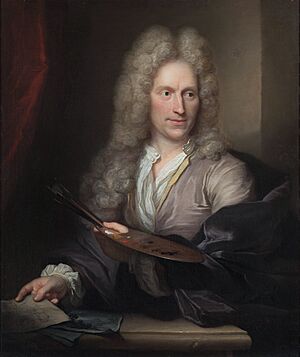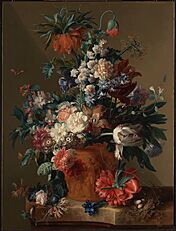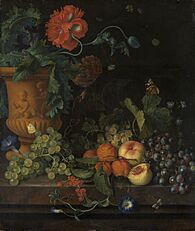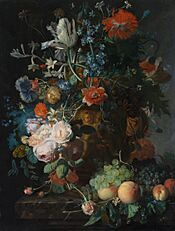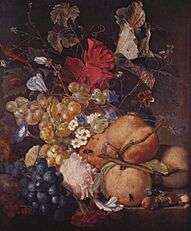Jan van Huysum facts for kids
Quick facts for kids
Jan van Huysum
|
|
|---|---|
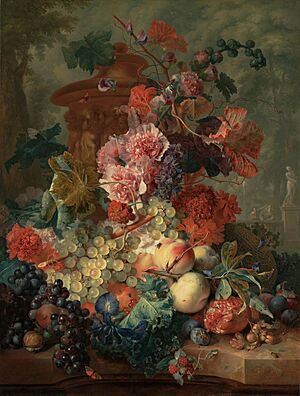
Fruit and flowers, 1722
|
|
| Born | 15 April 1682 |
| Died | 8 February 1749 (aged 66) Amsterdam
|
| Nationality | Dutch |
| Known for | Painting |
Jan van Huysum (born April 15, 1682 – died February 8, 1749) was a famous Dutch painter. He is known as the best painter of flowers from his time. Jan was part of the Van Huysum family, who were all artists during the Dutch Golden Age. This was a period in the 17th and 18th centuries when Dutch art was very popular.
Jan learned about art and decoration from a young age. He became very good at painting tiny details. His flower paintings were so amazing that you could see water drops and even ants without needing a magnifying glass!
Contents
Life and Art
Jan was the son of a painter named Justus van Huysum. He had several brothers who were also artists, including Jacob van Huysum. His grandfather, Jan van Huysum the Elder, was known for decorating doors and vases.
Jan van Huysum mostly lived and worked in Amsterdam. He and his wife, Elisabeth Takens, had 12 children. However, only three of them lived longer than their parents. Jan's daughter, Francina Margaretha van Huysum, also painted flowers. She might have helped her father with his art.
Jan was quite private about how he painted. He often worked alone, even from his own family. We know about his life from art dealers like Christiaan Josi and writers like Johan von Gool.
Jan's Famous Flower Paintings
Jan Van Huysum is considered one of the best painters of fruit and flowers. His still life paintings of flowers were very elegant. These paintings often showed beautiful arrangements of flowers. They were part of a style called vanitas or Pronkstilleven. These styles sometimes reminded people about how short life is, or showed off wealth.
After 1720, his flower pictures often had light or yellow backgrounds. These are thought to be better than his earlier works, which used dark backgrounds. He often painted on wood panels or copper instead of canvas.
Jan had a special way of painting leaves. He would first paint them blue, then add a brown or green layer over them. This technique was first used by Otto Marseus van Schrieck.
He painted flowers from "life," meaning he used real, fresh flowers. He would gather different flowers over time to create his bouquets. Sometimes, a painting could take a year or more to finish. This was because he had to wait for certain flowers, like a specific yellow rose, to be in season.
His Success and Buyers
Jan van Huysum was very successful during his lifetime. Important people like princes and kings wanted his paintings. His artwork sometimes sold for four or five times more than paintings by the famous artist Rembrandt van Rijn. Over time, his paintings have become even more valuable.
Some of his famous buyers included Prince William of Hesse-Kassel and Sir Robert Walpole. Sir Robert Walpole was a British Prime Minister.
His main competitor at the time was Rachel Ruysch. Another Dutch artist, Jan David de Heem, painted similar works before van Huysum.
His Influence
Jan van Huysum's paintings greatly influenced flower painting for 60 to 80 years after he died. Many artists were inspired by his style.
Some artists whose work was similar to Jan van Huysum's include:
- Jacob van Huysum (his brother)
- Justus van Huysum (his father)
- Pieter Faes
- Wybrand Hendriks
- Paul Theodore van Brussel
- Jacobus Linthorst
- Jan van Os
- George Jacob Jan van Os (Jan van Os's son)
- Gerard van Spaendonck
- Cornelius van Spaendonck (Gerard's brother)
- Coenraet Roepel
- Johannes de Bosch
- John Flaxman
Other Types of Art
While Jan van Huysum is famous for his flowers, he also painted landscapes. Some art experts thought his landscapes were not as good as his still life paintings.
About half of his paintings in public museums are landscapes. These often show imaginary lakes and harbors. They might have old ruins, classic buildings, and tall, still trees. These landscapes were very smooth and shiny, but sometimes looked a bit lifeless. His earliest dated landscape is from 1717. It shows a forest with maidens picking flowers near a tomb. There are also ruins and a distant palace by a lake with mountains.
His smaller landscapes are often seen as gentle and pleasing. They have many tiny details. However, his larger landscapes were sometimes considered weak.
Where to See His Art
You can find Jan van Huysum's paintings in many famous museums around the world. These include:
- The Louvre in Paris
- The Rijksmuseum in Amsterdam
- The Mauritshuis in The Hague
- The National Gallery in London
- The Hermitage in St. Petersburg
- Museums in Berlin, Munich, and Vienna
- The Dulwich Picture Gallery in London
- The Getty Museum in the United States
Around 1911, some of his best fruit and flower paintings were in private collections in England. These included collections belonging to important families like the Ellesmeres and the Hopes.
Gallery
- Selected works
The refinement of [Jan van Huysum]’s palette excels in its sophistication…Details, texture, defy description. Only an examination of the originals will suffice, as no process of reproduction can convey the subtleties of observation.
The Stolen Vase of Flowers
One of Jan van Huysum's paintings, called The Vase of Flowers, has an interesting history. It was stolen from Italy in 1943 during World War II. The German army, called the Wehrmacht, took it as they were leaving.
Many years later, on July 19, 2019, the German foreign minister, Heiko Maas, personally returned the painting. He gave it back to Italy's foreign minister, Enzo Moavero Milanesi, in Florence. The painting was then returned to its home at the Uffizi Gallery.


